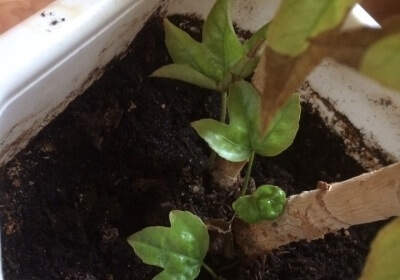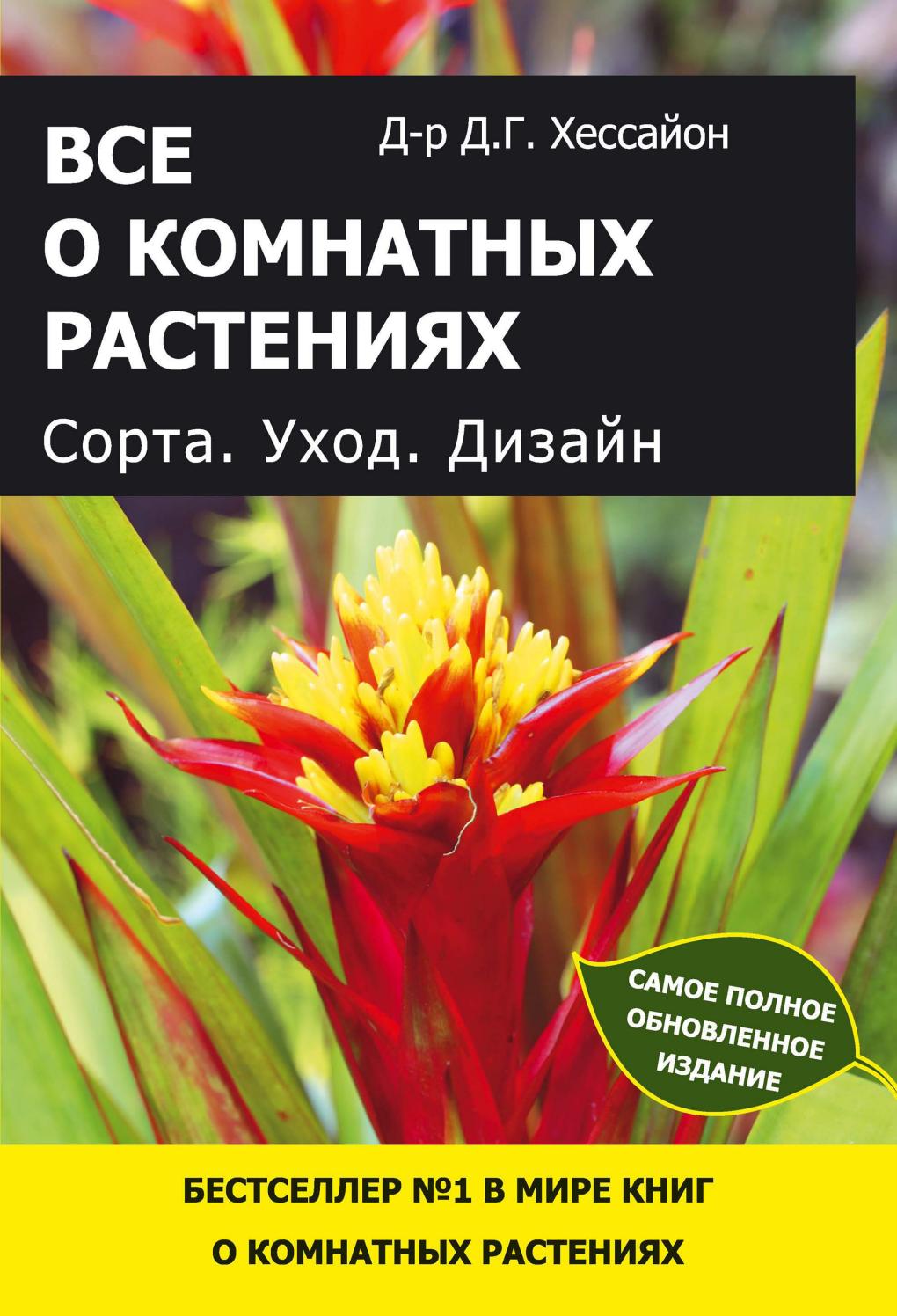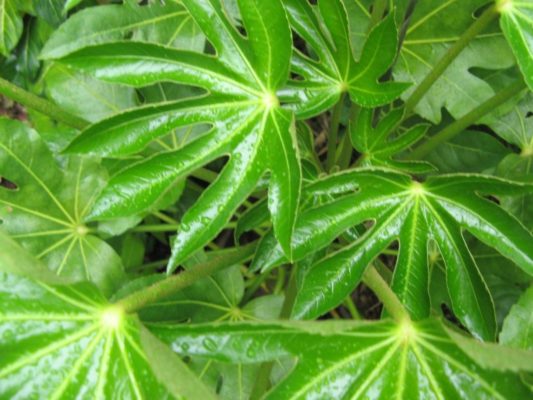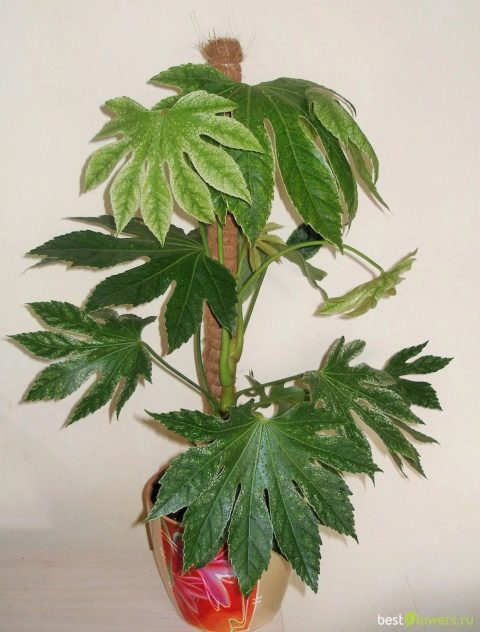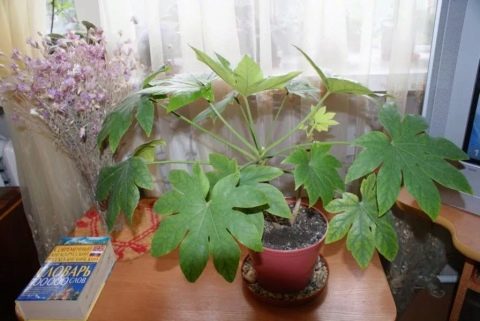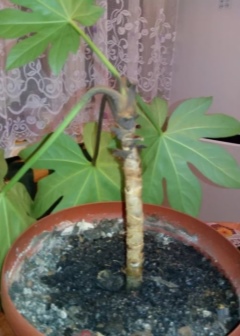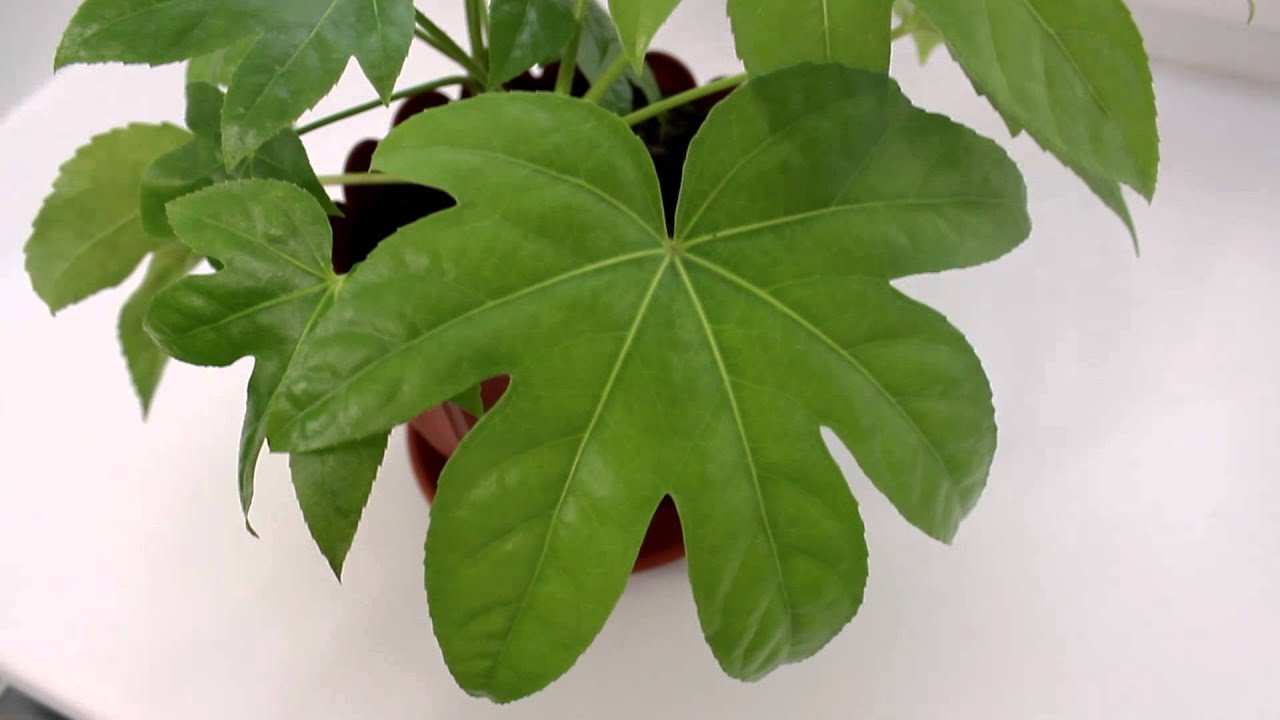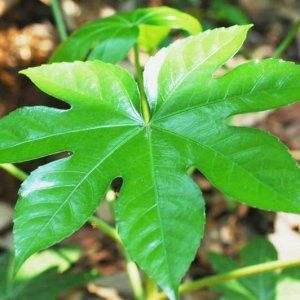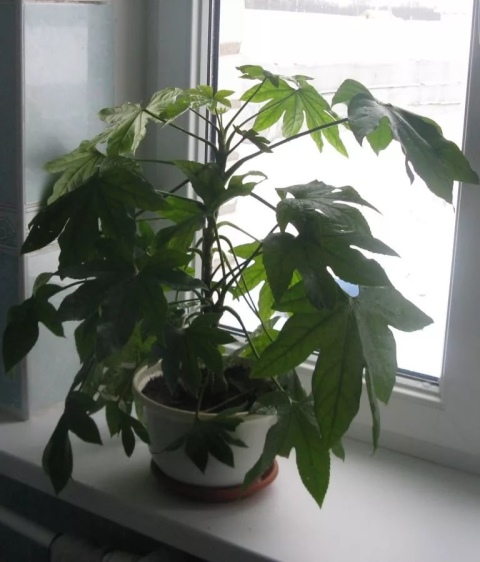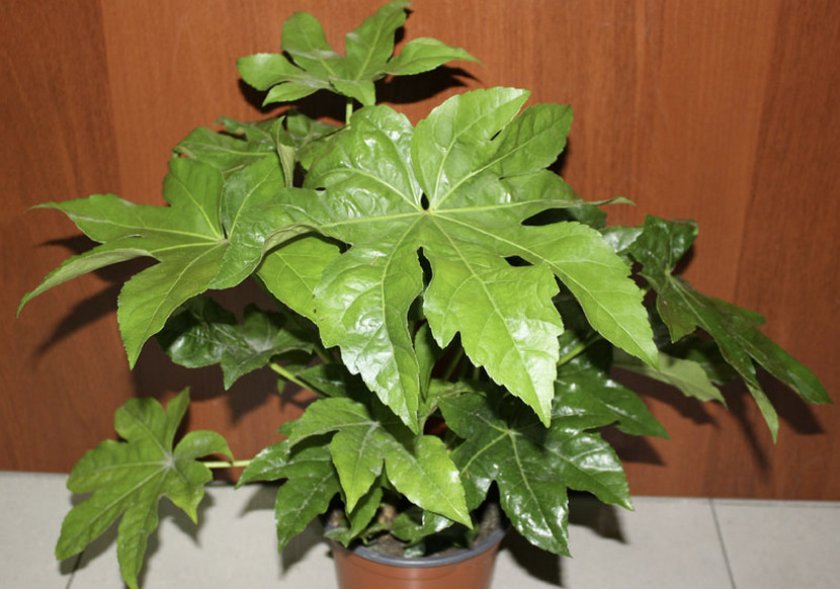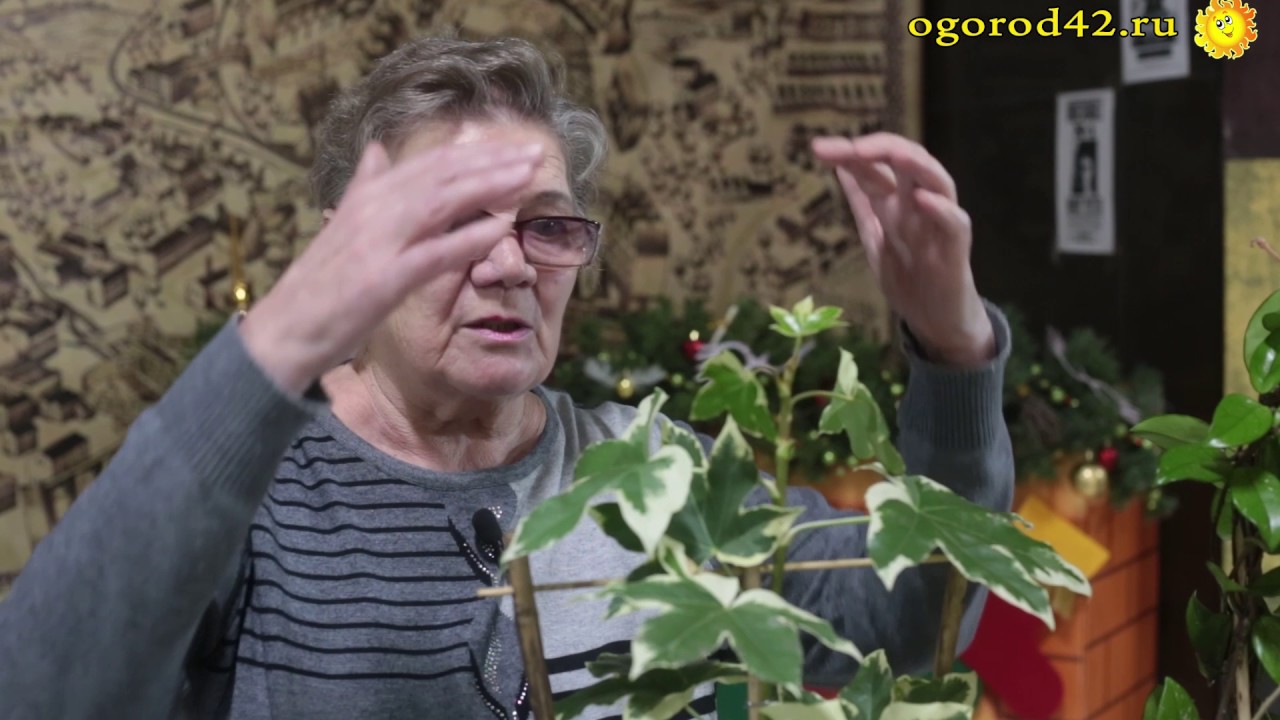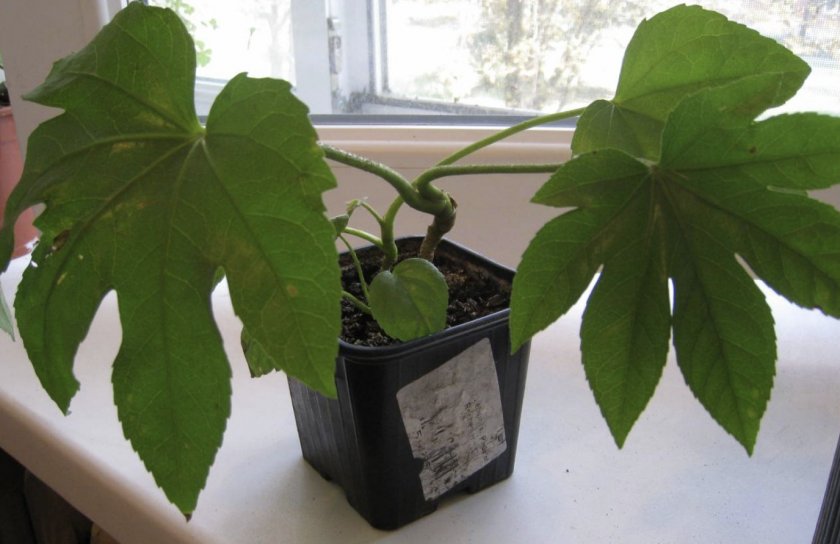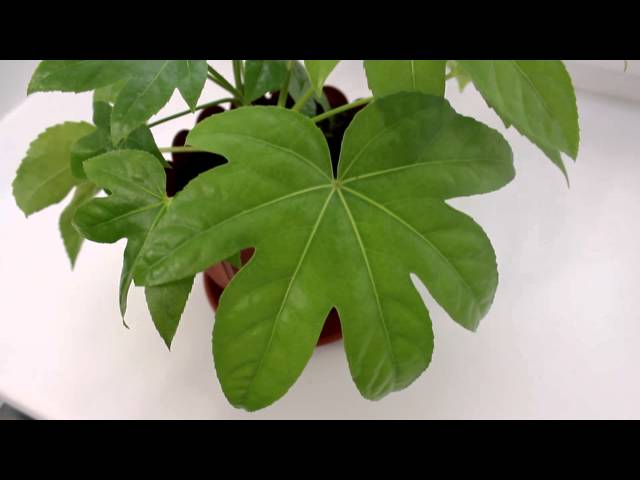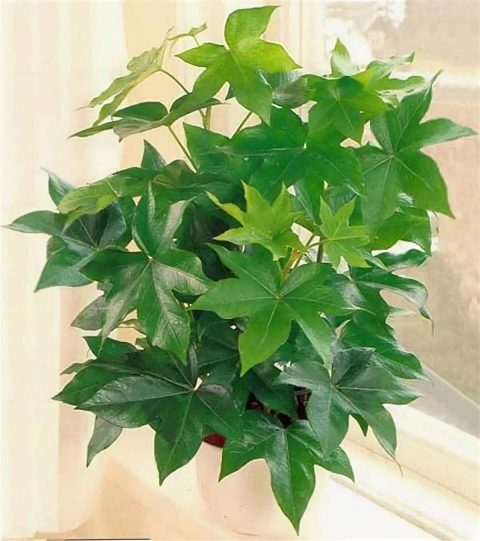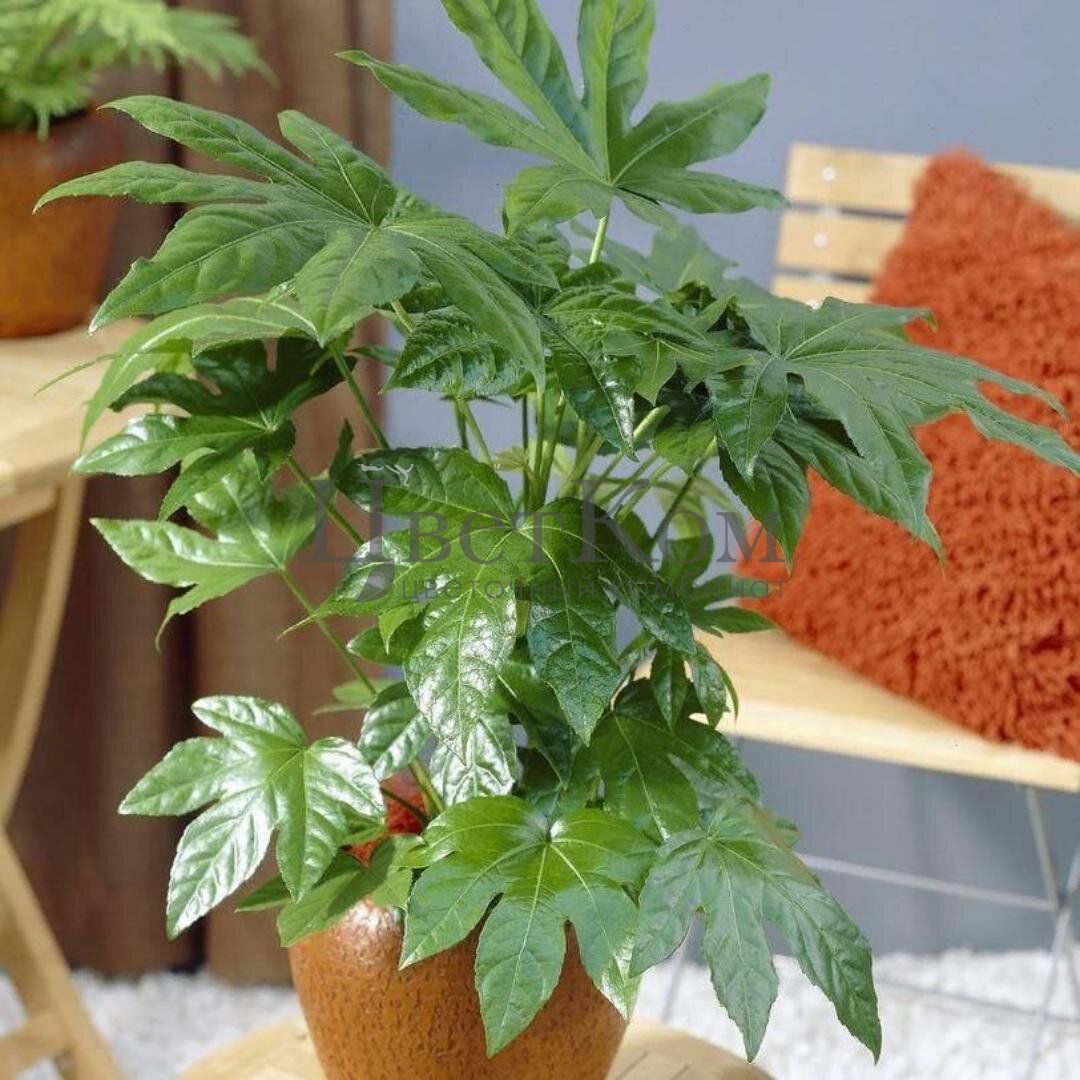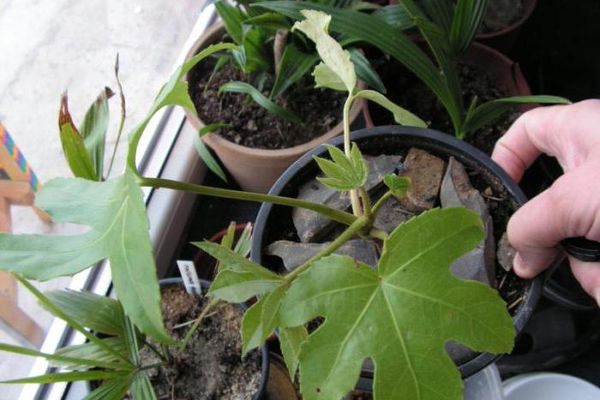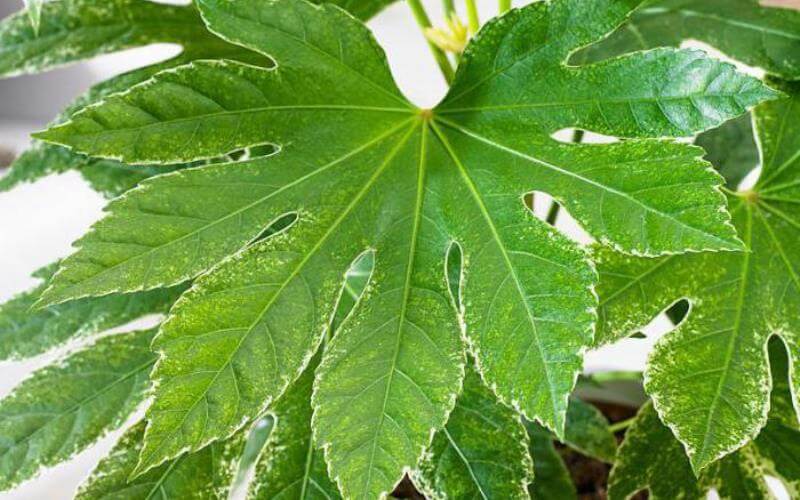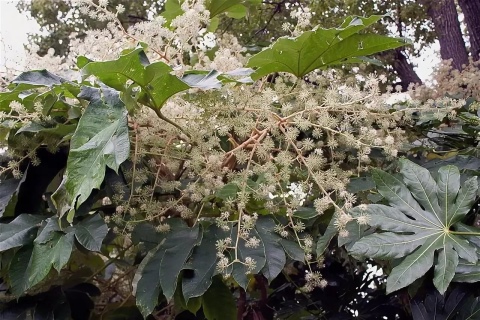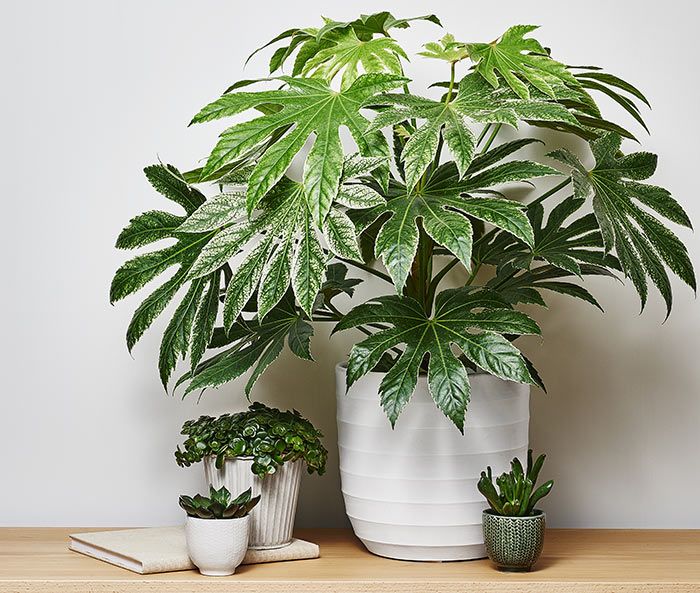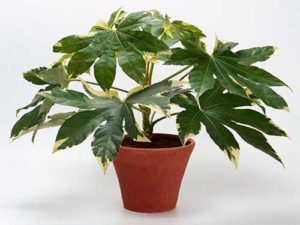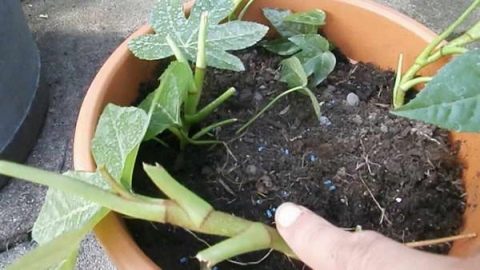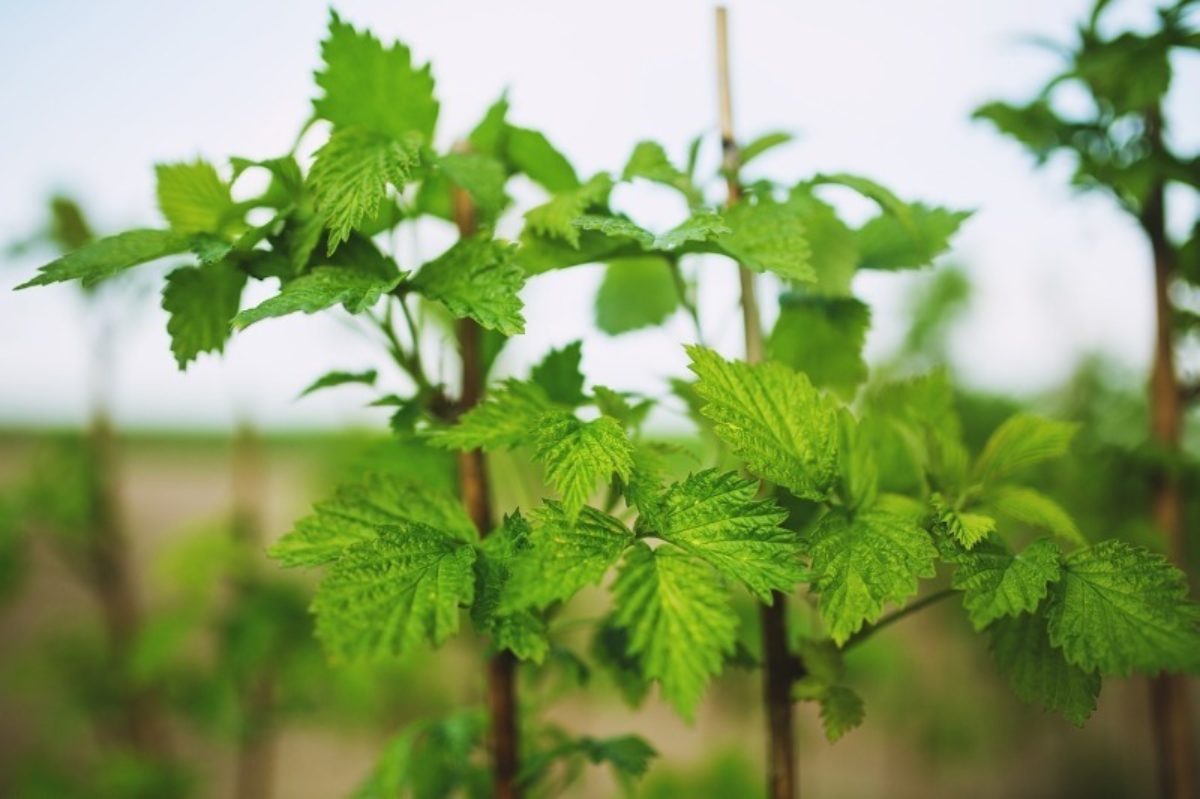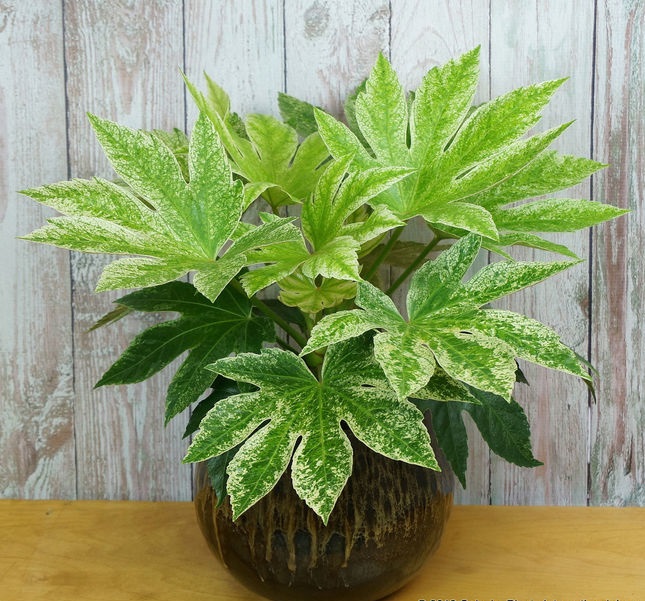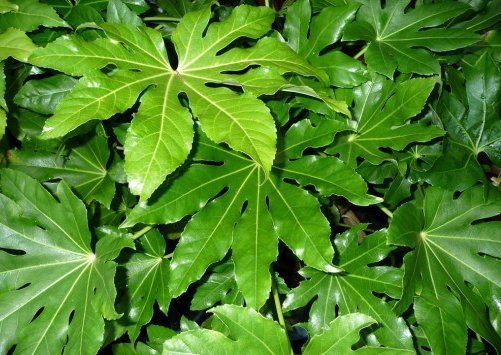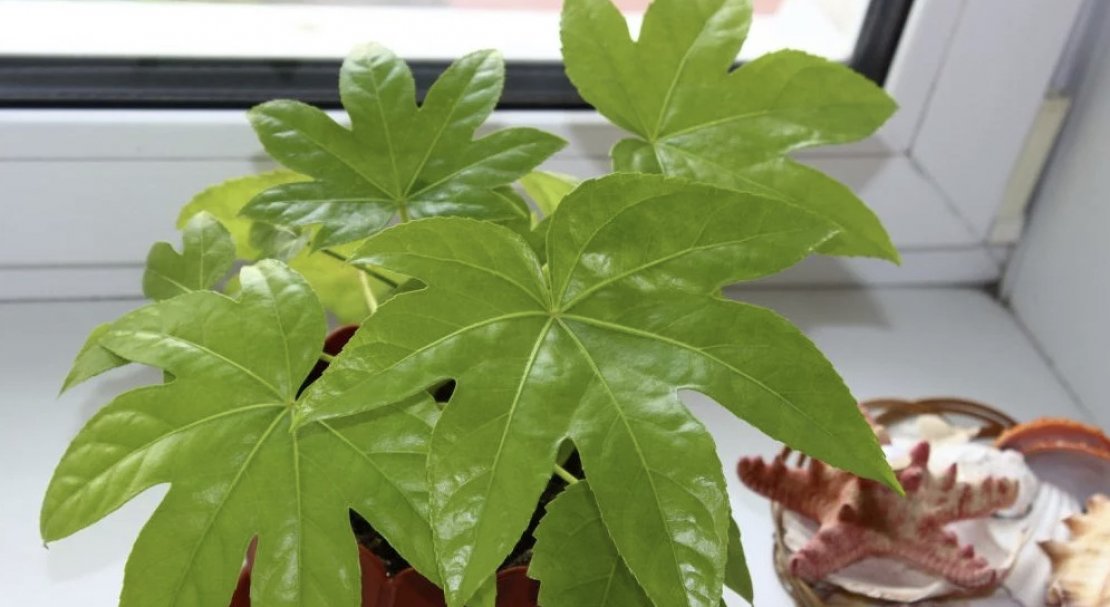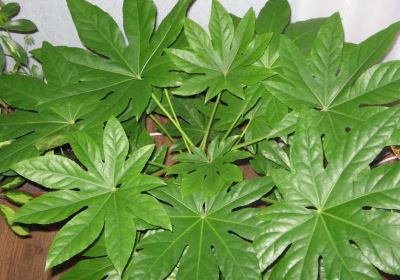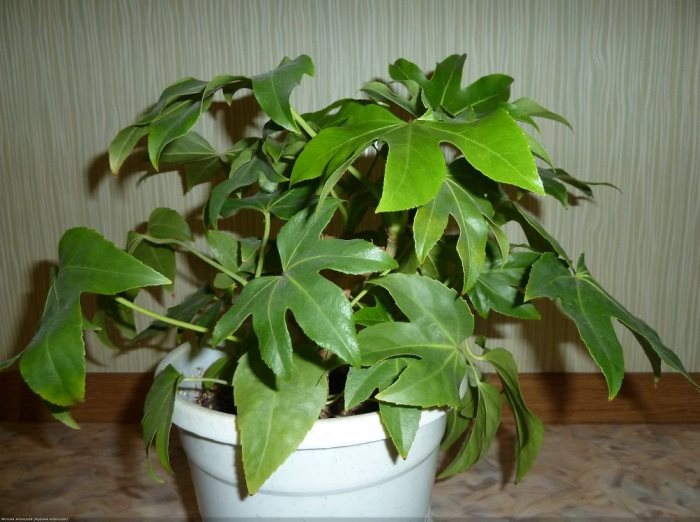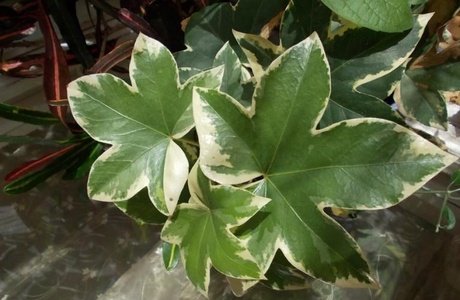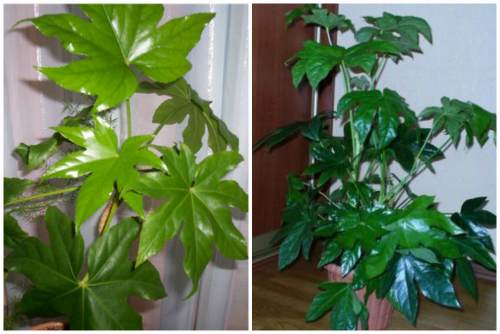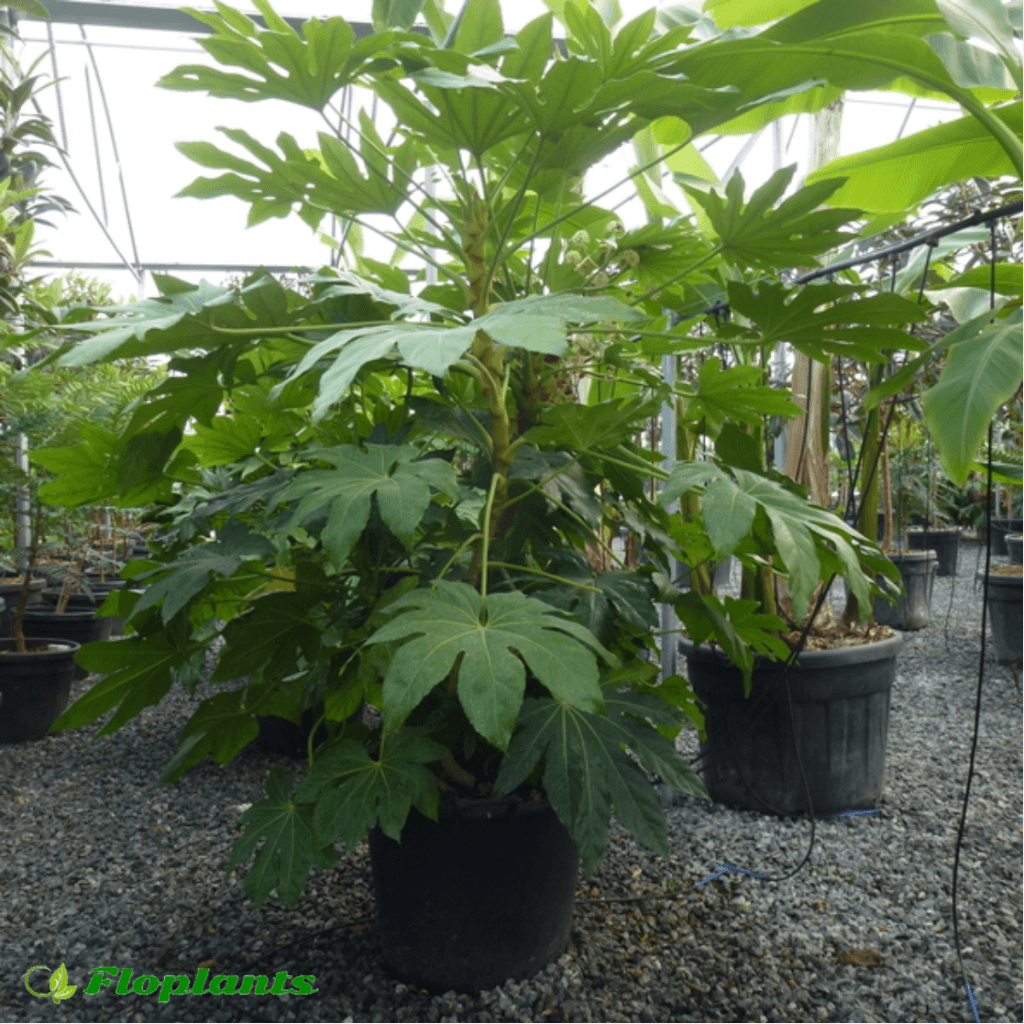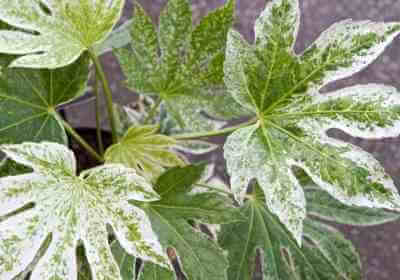Reproduction
Fatsia is propagated by seeds and vegetatively. Sowing seeds is carried out in early spring in March. To grow Japanese Fatsia from seed at home, you need a container filled with soil.
Seeds are spread on the surface of the soil at a distance of 5 cm from each other. Then they are pressed into the soil to deepen by 1 cm, and sprinkled with earth.
The container is placed in a warm place where the temperature does not drop below 18 ° C. The soil is regularly moistened with water spray. Under these conditions, the seeds germinate at 4 weeks.
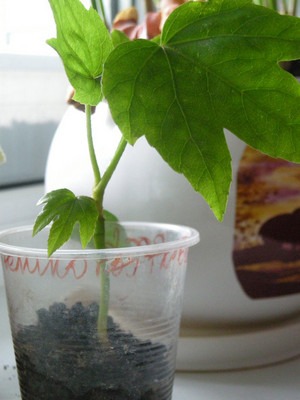 When the sprouts have 2 leaves, they are transplanted into separate pots.
When the sprouts have 2 leaves, they are transplanted into separate pots.
Fatsia is also propagated by apical and stem cuttings.
The best time for propagation of fatsia by cuttings at home is autumn.
Cuttings, which are about 20 cm long, are dropped into damp ground and covered with glass jars. They take root no earlier than a month later.
When the cuttings grow, they need to be dived into separate containers with earth and good drainage.
Brief description of cultivation

- Bloom. Fatsia is cultivated as an ornamental deciduous plant.
- Illumination. Species with green leaves can be placed in a slightly shaded place, but variegated species need bright diffused light.
- Temperature conditions. In the spring-autumn period, the air temperature should be from 17 to 21 degrees, and in the winter - from 13 to 15 degrees. If the plant is variegated, then it should not be allowed to be colder than 16 degrees in the room where it is located.
- Watering. During intensive growth, the bush is watered immediately after the top layer of the substrate dries. If in winter it is cool, then watering should be reduced to a minimum, but at the same time you need to make sure that the earthen lump does not dry out completely.
- Air humidity. It should be elevated. Experts advise to systematically moisten foliage from a sprayer, and also wipe it with a damp soft cloth.
- Fertilizer. During the growing season, the plant is fed once a week with organic matter or mineral fertilizers. If the flower is cool in winter, then you do not need to feed it. And when it hibernates in a warm place, feeding is carried out no more than once every 4 weeks.
- Pruning. Held in the spring. There are varieties of fatsia that need to be shortened regularly.
- Transfer. A flower is transplanted once every 3 years in the spring or in the first summer weeks.
- Soil mixture. Leafy, turf and humus soil, as well as sand and peat (1: 1: 1: 1: 1).
- Reproduction. Seed and vegetative (layering, cuttings) method.
- Harmful insects. Whiteflies, scale insects, spider mites and mealybugs.
- Diseases. If the plant is not properly cared for or is in the wrong conditions for it, it may have problems with foliage.
- Properties. All parts of such a plant contain poison.
Japanese Aralia / Fatsia / Japanese houseplants
Japanese fatsia - home care
It would be untrue to write that home care for such a plant as fatsia is simple. It is necessary to observe not only the temperature regime, but also the optimum air humidity. Otherwise, various diseases await fatsia.
Temperature
Warm atmosphere is considered best for Japanese Fatsia. According to the rules of care, the average temperature that should be adhered to at home should be around 19 degrees.
The temperature should definitely not exceed +21 and be below +17 degrees, otherwise the fatsia grows worse, quickly turns yellow.
Lighting
In indoor conditions, the flower should be in a somewhat shaded place. This is due to the fact that fatsia does not tolerate exposure to direct sunlight.
The best way out is to orient the flower to the north side. On the south windows there will be an additional need to shade the fatsia.
Watering
For the correct observance of the water regime, it is necessary to assess the topsoil. As soon as it starts to dry, you need to water the plant.
An indoor flower does not tolerate excessive moisture well. Destructive for fatsia and drying out. Therefore, drainage holes are needed, but deep trays are not.
Spraying
To maintain proper care for such a capricious houseplant like fatsia, wiping the sheets with a damp sponge is recommended.
Attention! On hot days, at high temperatures, the plant is sprayed with warm water. Humidity
Humidity
Given that all aralia plants are native to the tropics and subtropics, humidity must be maintained at a high level.
Therefore, it is very important to spray the plant, as well as periodically wipe the leaves with warm water. It is also necessary for the prevention of various diseases.
Priming
The ideal mixture for fatsias contains earth, peat and sand. They must be present in equal amounts. The land is sod or leafy.
Pay attention to the acidity index - it should not be lower than 5.0 and not higher than 7.0 pH. Top dressing
Top dressing
The plant reacts gratefully to fertilizers. The main thing is not to overdo it. For example, in winter, feeding is not needed at all. But in the summer, organic fertilizers can be added once a week.
Features of care in winter, dormant period
In winter, the plant should be looked after more carefully. Additional lighting is required using fluorescent or fluorescent lamps.
Attention! The temperature regime changes somewhat - it is better to withstand values not exceeding +16 degrees. Pruning
Pruning
Pinching the tops of the shoots helps the plant to branch. This preserves the necessary beautiful shape of the crown of the shrub.
The plant tolerates pinching. Therefore, pruning can be done several times a year.
Types of Fatsia
There are several varieties of fatsia, but the plant itself is monovid. The presence of several varieties contributes to the expansion of the assortment and allows you to choose any one to your taste.
Japanese fatsia
This is the original variety, basic and "pure". They also call Aralia Japanese, Zibolda, Room Aralia or Home Chestnut. The main difference and sign of this particular flower is the presence of at least 7 -9 branches on the leaf. Reaches up to one and a half meters in height if it grows in nature. Indoors, usually a lush hat of leaves is formed according to the wishes and possibilities of the room's height and ranges from 1 meter, which the fatsia reaches in the first year of life. It has varieties that differ in some characteristics, mainly in the color of the leaves:
- "Moseri" is a small shrub in size, suitable for fans of small compact plants.
- "Variegata" - the leaves are green with cream and white streaks.
- Fatsia "Annelise" is a very original flower with yellowish - white leaves with a golden tint.
- "Nishiki" is a light yellow color.
- "Spider's Web" is one of the most famous for its vibrant colors - white splashes spread over a green leaf.
- "Tsumugi Shibori" - reminds "Spider's Web", the only difference is more white spots.

"Fatshedera Lizei"
It is a hybrid of common ivy and Fatsia Aralian. The main difference is that there are only three or five paws on the leaves. This large plant, it is often decorated with winter gardens, large pavilions and halls, pillars and walls of sales areas - belongs to the type of plant for vertical gardening.
It can also be used on terraces and garden areas in partial shade as well as in well-lit places. It can be in the form of a curling, ampelous bush. You can choose and shape at will and depending on the size of the room.
Features of Fatshebera
- They are usually located in the west or east, where there is more light, but it is also possible on the north side of the room, creating additional lighting.
- Grown as an evergreen liana, it can reach a height of up to 5 meters. You can plant on a personal plot, but preferably in regions with a mild climate in winter.
- The stem of such a plant does not creep in the first year, but later, slightly branched, the leaves are dark green, sometimes with a white border. Variegated varieties like the sun more, grow more slowly and are less hardy. More suitable for indoor use, bamboo sticks are used to support the stems with leaves. They also pinch repeatedly so that it grows a little in breadth.

Reproduction of fatsia
There are three ways. New fatsias are obtained vegetatively (by cuttings and layering) or by sowing seeds.
Cuttings
This is the fastest way to get a new plant. Reproduction is carried out in the spring, can be combined with summer pruning.
- Cut off shoots with 2-3 upper buds and dip in a solution of zircon or epin (stimulants);
- Then, bury the cuttings in a sandy-peat substrate filled up in a container;
- Cover the plants with transparent lids or glasses made of glass or plastic, put in a bright, warm place, periodically water and ventilate;
- After the roots appear, transplant from the container to the pots.
Layers
This breeding method can be used if the trunk of the fatsia is bare.
- Make a circular incision on the trunk, put moss soaked in the stimulant on this place and wrap it with polyethylene film. Moss the moss constantly.
- After 4-6 weeks, roots will appear in this place. They need to grow and get stronger for another 1-1.5 months, and then cut the trunk just below them and plant it in a pot with nutritious soil.
- Cut the remaining trunk to the ground and water regularly - it can give new shoots.
Seeds
This seed can be obtained from a home plant, but since such seeds rarely ripen and may not germinate well, it is best to buy them at the store. Fatsia grows normally if the planting material is fresh and well-ripened. This type of breeding is the cheapest.
- Prepare soil from sheet and turf soil, sand, pour it into a container (container).
- Plant each seed to a depth of 1 cm. Keep in a bright place at a temperature of +18 C. Transplant the hardened seedlings into separate containers with a different soil mixture: from turf soil, sand and organic matter.
Reproduction of fatsia
This is she of the easiest large-leaved crops to reproduce. For fatsia, both the vegetative method and the seed method are suitable.
Getting fatsia from seeds is not easy. Good germination is characteristic only of very fresh seeds, and it is not easy to collect them on your own. Fatsia seeds are sown in a moistened nutrient substrate, covering 1 cm of sifted soil on top. Germinate seeds in warmth and in bright light under film or glass. As soon as the first pair of full-fledged leaves appears on young plants, they dive into small individual pots and begin to grow according to the same principles as adult plants.
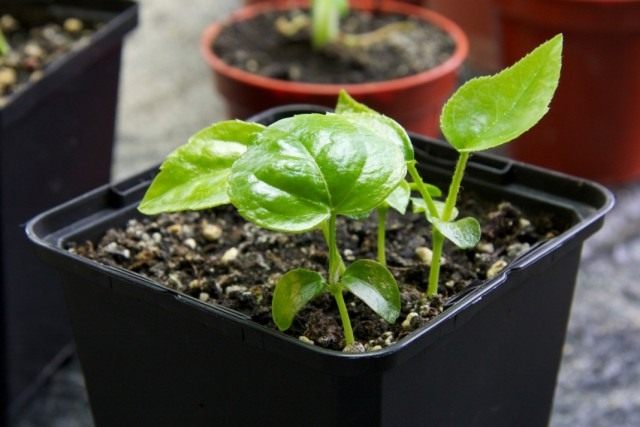 Japanese Fatsia seedlings. Dan Kristiansen
Japanese Fatsia seedlings. Dan Kristiansen
Of the vegetative methods, the apical cuttings are the easiest to use. They are cut only in the spring, before or after transplanting, at the very beginning of the stage of active growth, choosing shoots with slightly swollen or swollen buds. For rooting, cuttings will need treatment with growth accelerators, hot temperatures from 25 degrees Celsius and greenhouse conditions - covering with a cap or film. The cuttings are deepened to a depth of 2 cm in a mixture of sand and peat. It is better to plant the plants in individual small pots immediately after rooting. It is from the cuttings that the thickest and lowest fatsias are obtained.
Air layering is a great fallback option. But you can get them only if for some reason the leaves of the Fatsia have fallen off or are bare, the shoots are stretched out.Between the nodes, the trunk is cut vertically, wrapping the cut with wet moss or substrate (it is better to water them with a solution of a growth accelerator) and fixing it on the stem with foil or other materials. Rooting will take several months, but the fatsia obtained by this method will start growing faster after planting.
Diseases and treatment
Japanese Fatsia is particularly resistant to diseases, however, if the owner treats her carelessly, then she can cause a lot of problems.
- Poor lighting and poor soil causes a deterioration in the appearance of the Fatsia: its variegated leaves lose brightness, and the stems become lethargic. Hang up the feeding schedule in a conspicuous place and arrange additional lighting with fluorescent (phytolamps) for 10-12 hours a day.
- If the plant has stopped growing, most likely, it has become too cramped in the pot. This is also indicated by the roots peeking through the drainage holes. Transfer it to a wider pot.
- Gray rot is a real scourge of domestic plants. And it does not appear out of nowhere. The owner of the flower is to blame for this, watering the plant too much. If you notice a brown or gray bloom on the stem, take urgent action: transfer the plant to a new pot with a substrate. Do not forget to clean the roots of the old soil as much as possible, cut off the damaged roots and treat the rest with a weak solution of potassium permanganate or fungicide. Unfortunately, in a neglected case, it will not be possible to save the plant.
- Why is it shedding leaves? Fatsia does not like excessive temperature drop.
- If the air in the room is too dry and hot, the foliage shrinks, becomes dull and brittle. Frequently wipe the flower with a damp cloth, bathe in the shower, and cover the batteries with damp towels.
- Are the leaves drying out? The soil is too dry. Do not wait for the earthen coma to dry completely.
Fatsia care rules
Like every plant, home or Japanese chestnut needs proper care, maintaining the required air temperature where it grows, as well as competent fertilization and timely transplantation. In principle, the plant is unpretentious, and adherence to the simplest rules will ensure the attractive appearance and absence of diseases.
Watering plants and moisture levels
- The plant does not like wind and excessive moisture. It is better to keep a decorative view at a temperature of 16 - 17 degrees, other plants are better from 12 to 15.
- In summer it is watered often, but little by little. Waterlogging should not be allowed, because the leaves may turn yellow, lose their shine and elastic structure. Water sparingly in winter. It is necessary to ensure that the earth does not dry out, which is fraught with the omission of leaves. It will be very difficult to restore beauty to the plant in this situation. In order not to dry out, you can pour a little water into the pan if the temperature in the room is more than 20 degrees. The leaves should be wiped once a week with a soft, preferably flannel cloth. Spraying is recommended several times a month.
- In hot weather, a warm shower is sometimes done. The plant must breathe and dust on the leaves is unacceptable.
Strong moisture and drying out of the soil can equally harm fatsia. Therefore, it is simply necessary to control and regularly check the condition of the soil.

Fertilization and transplantation of fatsia
In spring, summer and autumn, the bush is fed with mineral and organic fertilizers, at least 1 time per month, during the active period every 10 - 12 days. In winter, you do not need to fertilize, since the plant is resting and at rest. It is advisable to use fertilizers for decorative deciduous varieties with nitrogen content.
Young plants are transplanted annually. Then, only once every few years, this process is relevant. The soil is composed as follows:
- Be sure to make good drainage. This is one quarter of the pot.
- Transplanting is carried out only in sod soil, which consists of equal parts of sand and humus. Some leafy soil and peat may also be added.
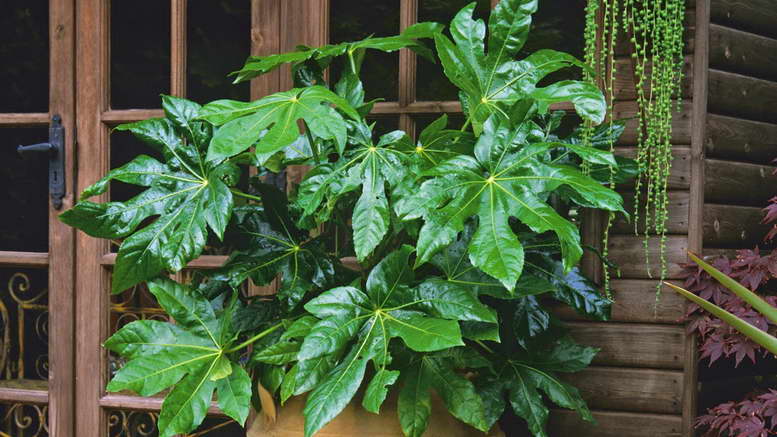
Reproduction of fatsia - cuttings or layering
These two types of reproduction apply equally to the Japanese woman. This is best done in late winter and early spring. The air lay is done like this:
- A shallow incision is made on the stem.
- A piece of moss is applied, which should always be moist.
- The stem with moss is wrapped in polyethylene.
- When the root appears, after about 8 weeks, the top with a new root is cut off and planted in a separate pot.
Fatsia cuttings will root quickly when placed in a moist substrate or water. The cutting itself should have several buds.
It is necessary to cover the sprouts on top with glassware or foil, thus providing the plant with increased humidity (the temperature should be up to 27 degrees). When the roots appear, the fatsia is seated in separate pots.
We offer a short video for a better acquaintance with the Fatsia:
Conditions of detention
Despite the unpretentiousness and good survival rate, fatsia still requires the creation of certain conditions.
Temperature and humidity
The most favorable temperatures for the spring, summer and early autumn periods are considered to be 20-24 °.

In most cases, this is normal room temperature and no additional heating or cooling measures are usually required. Winter is another matter. During this period, the temperature must be maintained within the range of 16-18 °, and for some varieties, not at all higher than 10-15 °. This is due to the dormant state in which the plant stays from October to March.
However, observing the temperature regime is more a recommendation than a mandatory action, and if it is not possible to create such conditions, then this will not be critical for a plant: the fatsia is able to winter safely both on a glazed loggia and in a warm room.
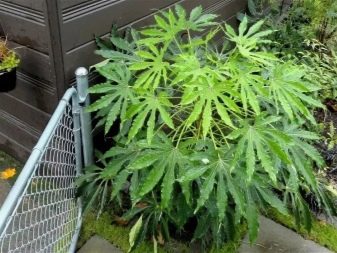
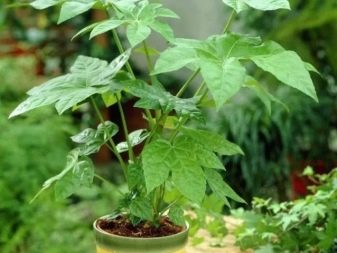
The second important condition for growing a flower is moisture. Due to the large surface of the leaf plates, transpiration processes are quite active. And if the loss of moisture to the plant is not compensated for in time, the leaves will begin to dry out and lose their decorative effect.
To increase the humidity of the air, they resort to daily spraying of the flower with soft water at room temperature. In winter, the regularity of humidification is reduced, guided by the air temperature in the room. So, if the room is cold, then the irrigation is suspended for the entire dormant period, and if it is warm, then it is reduced several times.
Lighting and location
Fatsia does not tolerate exposure to direct sunlight and should be located at the back of the room. Alternatively, east and west windows are suitable, provided that the flower is moderately shaded. To do this, you can place the plant in the shade of taller species or artificially diffuse the lighting using a tulle curtain or gauze. However, you cannot choose a too dark place for a flower.
The lack of ultraviolet light significantly slows down development, and as a result, the flower may stop growing. Therefore, large adult plants are usually placed in the shade in order to slightly restrain their growth and preserve decorativeness.
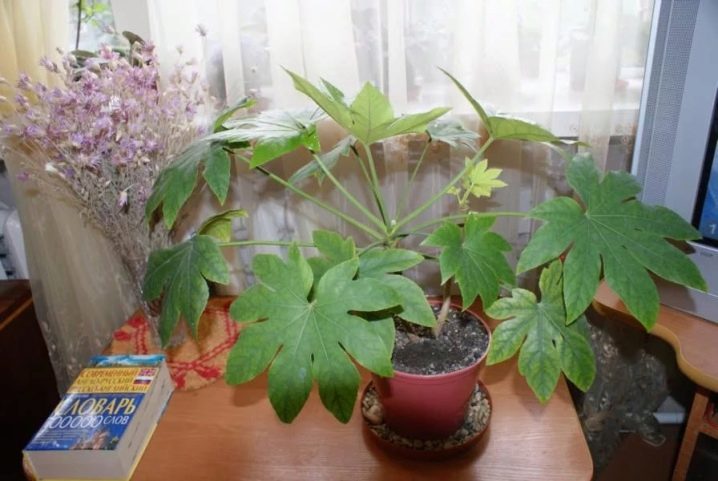
Hybrid varieties with variegated and patterned leaves are considered especially sensitive to lack of lighting, which is why they are recommended to be placed in a brighter room. Less demanding is variegated fatsia, which tolerates shading well and can be grown in apartments with north-facing windows. Most varieties are not too demanding on the level of illumination and are perfectly adaptable to any light conditions.
The following video talks about caring for Fatsia.
Home care
The main activities that have to be carried out as part of caring for fatsia at home are not difficult.
Lighting
When choosing a lighting mode, you must focus on the color of the plant.Fatsia, the leaves of which are covered with a large number of variegated spots, need the brightest possible lighting. However, direct sunlight can harm plants, so they need to create artificial shade at noon to avoid burns. Instances with dark green leaves will do better when grown in partial shade. This flower can grow well in the shade, as well as in conditions of artificial lighting with fluorescent lamps. In the summer you can keep it outdoors, where it will feel even more comfortable.
Temperature regime
In spring and summer for fatsia, it is necessary to maintain the temperature within 17-21 degrees. At the first signs of a cold snap, plant care should be adjusted taking into account the color of the leaves. Variegated bushes do well at temperatures no lower than 16 degrees. Plants with solid green leaves can tolerate temperatures as low as 14 degrees.
It should be borne in mind that when growing fatsia at home, it is necessary, depending on the temperature, to regulate the lighting. In hot weather, plants should be provided with plenty of light.
Watering
 Plants cannot grow without regular moisture. Therefore, it is necessary to irrigate regularly. If you skip them just once, then the plants will react to this immediately: the leaves will drop, and you will have to wait a long time for them to return to their original position. However, when irrigating, it is necessary to observe the measure, since with excessive irrigation there is a danger of root rot, and this will lead to the fact that the plant will lose its former attractiveness.
Plants cannot grow without regular moisture. Therefore, it is necessary to irrigate regularly. If you skip them just once, then the plants will react to this immediately: the leaves will drop, and you will have to wait a long time for them to return to their original position. However, when irrigating, it is necessary to observe the measure, since with excessive irrigation there is a danger of root rot, and this will lead to the fact that the plant will lose its former attractiveness.
In summer, when determining the frequency of watering, it is necessary to focus on the degree of moisture in the upper surface layer. Noticing that he began to dry out, you should immediately carry out the next watering. In winter, the main guideline for irrigation is the air temperature in the room. In cooler conditions, irrigation is needed less frequently. If the temperature in the room is high enough, then the fatsia is watered in the same way as in the summer.
Spraying
It is possible to maintain sufficient hydration of the Fatsia when growing at home through this important procedure. In the summer, it should be regular, in some cases, when the heat is intense, it may be necessary to water from the shower with warm water.
In winter, fatsia is sprayed much less often.
Top dressing
In winter, fatsia is at rest, so no feeding is required. In the spring, when the plant wakes up, it will take a lot of strength. Therefore, starting from this time, complex fertilizers are applied to the soil at intervals of two times a month.
The soil
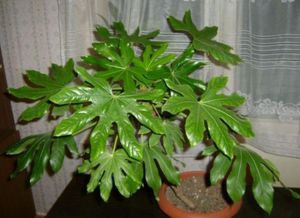 Wild species usually choose places where there is a lot of humus. In this case, the soil should have a normal acidity reaction or slightly acidic. You can maintain the necessary balance of soil acidity at home by using special planting soil.
Wild species usually choose places where there is a lot of humus. In this case, the soil should have a normal acidity reaction or slightly acidic. You can maintain the necessary balance of soil acidity at home by using special planting soil.
For its preparation use:
- turf soil (2 parts);
- humus from leaves (1 part);
- sand (1 part).
If it is not possible to prepare a soil composition on your own, then it can be replaced with a store-bought ready-made soil. It is also allowed to be used for growing hydroponics.
Growing fatsheders indoors
The indoor flower Fatskhedera is unpretentious and shade-tolerant, however, not all growers manage to grow it healthy and lush. When breeding, it is worth considering the characteristics of this plant.
Location. It is believed that this crop can grow successfully in the shade, but in practice it develops better with good lighting, even in winter. For her, the best place in the house will be the west or east window. The south side is not recommended for a permanent place of fatshedera, as the sun's rays can burn its leaves. Variegated varieties of this plant need an abundance of sunlight.In the shade and partial shade, they lose their pattern, and hence their decorative effect.
Temperature. When caring for a fatshedera, it is necessary to create a moderate air temperature in the warm season (from 20 degrees and above), and in winter not higher than 20 degrees and not lower than 10 degrees. Ivy freely transfers dry indoor air.
In winter, an exotic flower needs a rest period. At this time, it should be removed to a cool place, for example, on a loggia, where there will be enough sunlight. You can keep it in the apartment in winter, but place it on a windowsill with a temperature slightly lower than in the room.
Watering. From spring to autumn, when caring for a Fatshedera at home, abundant watering is required, but moisture stagnation in the soil should not be allowed. To prevent this from happening before watering, check how dry the earthen lump is. If the soil is half dry, you can water the plant. In winter, watering is done less often - as the soil clod dries up.
Fatshedera has large, dense leaves that evaporate a lot of moisture, the reserves of which must be replenished in order to avoid yellowing and drying out. To do this, it is useful to arrange water procedures: spray ivy with soft warm water from a spray bottle, put it under the shower, or wipe the leaves with a damp cloth. During the rest period, this work is not necessary.
Substrate. The soil should be loose, with neutral acidity. The substrate is made up of turf, humus and sand (2: 1: 1). In order to prevent stagnation of water in the container, it is necessary to arrange drainage from a mixture of expanded clay, broken brick, filled up to 0.3 of the height of the container.
Top dressing. Caring for the Fatskheder flower from March to August, it is fed with fertilizers for decorative leafy plants with a high nitrogen content. They should be entered in spring-summer period, increasing the volume during the growing season.
Transplants. In order to get a lush bush, young plants are transplanted annually, choosing a capacity slightly larger than the previous one. It is enough to transplant adults once every 4 years.
Pruning. Fatskhedera responds well to shaping, so it is easy for a grower to give ivy the desired shape by directing the branches to the desired position: up along the created support, or down, hanging long shoots from the pots. Ladders, arches, cones and other structures are perfect as supports. With the help of such a flower, the most complex plant compositions are created.
To make more shoots appear on the plant, it is cut off. This helps to make it lush and bushy. You can achieve maximum splendor by planting several ivy seedlings in one pot.
Some difficulties can arise when growing a plant. The main ones are listed below. Yellowing and falling leaves. Reason: improper plant care.
Brown spots on the leaves are the result of exposure of the plant to direct sunlight.
Sometimes on the shoots you can find a fluffy bloom that looks like mold. This suggests that Fatsheder was struck by the gray rot disease. To cure ivy, you should remove the decayed parts and treat the flower with fungicides.
For the prevention of diseases, it is necessary to create optimal conditions for the normal growth and development of indoor ivy.
Watch a video about caring for a Fatshedera at home, which will help you avoid many mistakes when breeding exotic ivy and grow a lush, beautiful bush.
Fatsia cultivation and care
Fatsia is undemanding to lighting, it grows well both in the sun and in partial shade, only variegated forms of fatsia need stronger lighting. Fatsia will be fitted with western and eastern windows. In summer, she will be fine in the fresh air, if you protect her from the sun. During the period of active growth, the optimal temperature is 18 ° -20 ° С, in winter, a bright room with a temperature of 10 ° -15 ° С is preferable. Variegated forms love the air warmer, not lower than 16 ° C.Fatsia needs to be fed from spring to autumn every decade with organic and mineral fertilizers for deciduous plants.
In warm weather, fatsia needs regular spraying of the leaves. You can wipe the leaves with a wet sponge, but sometimes it needs to take a warm shower. Since autumn, air humidification is reduced, and in winter, in a cool room, they stop altogether.
Water the fatsia with care, because insufficient watering will force the plant to drop its leaves, which will be very difficult to straighten. Check the soil all the time: you need to water it with settled water as soon as the top layer of the soil dries up
In autumn, watering is gradually reduced, and in winter, it is significantly reduced. From waterlogging, the leaves turn yellow and fall off, the tips of the leaves dry from a lack of water.
Fatsia propagates, like Fatskhedera, in the spring by air layers and apical cuttings. Cuttings with several swollen buds are rooted in a sandy peat substrate at 22 ° -26 ° C, covered with a jar or polyethylene. When the cuttings are rooted, they are transplanted into the soil. The soil for fatsia should consist of sod land (two parts), humus soil, sand and peat (one part each). Young plants need to be replanted every spring, older plants after 2-3 years. Expanded clay should occupy a third of the pot.
Mealybugs, whiteflies, red spider mites, aphids and gray rot can affect fatsia. Red spider mite is destroyed with 15% actellic solution, gray rot - by reducing air humidity and mechanical elimination, aphids and whiteflies - with soap solution and actellik, mealybugs - with soap and karbofos.
Policeman Schefflera
After this article, they usually read
Add a comment
Fatsia care
Fatsia love a bright place, but not sunny, they easily tolerate slight shading (variegated ones need more light; plants with monochromatic green leaves are more shade-tolerant). Suitable for growing by the windows of the western and eastern exposure. South exposure windows require shading from direct sunlight. It is better to grow green-leaved forms near the windows of the northern exposure. Fatsia can be successfully grown under artificial lighting.
In summer, fatsia can be taken out into the fresh air, in a place protected from direct sunlight.
In the spring-summer period, the optimum air temperature for Fatsia is 18-22 ° C. In winter, plants can tolerate normal room temperature, but it is best to keep them in well-lit rooms at cooler conditions (10 ° C, if possible, no higher than 15 ° C). In the case of warm winter content, it is recommended to provide additional fluorescent lighting for the Fatsia. For variegated forms, winter temperatures should not drop below 16 ° C.
Water the fatsia abundantly in the summer, as the upper layer of the substrate dries up, with soft, settled water. Watering is reduced since autumn. In winter, when the plants are kept in cool conditions, watering is significantly reduced, without causing the soil to dry out. In the case of the content of fatsia and especially fatsheders at a higher winter temperature, watering should not be greatly reduced, it is necessary only 2-3 hours after watering, when the entire earthen lump is completely moistened, pour out excess water from the pan.
Special attention should be paid to watering the plant. On the one hand, it is impossible to allow stagnation of water on the pallet, on the other hand, drying out of the soil
If you dry out the soil at least once, the plant may drop the leaves, and it will be very difficult to return them to their previous position. Even very heavy watering will not help you. In this case, the leaves must be tied to spacers in a horizontal position. After some time, the plant may acquire its original characteristic silhouette.
Large leaves should be regularly sprayed with soft settled water and wiped with a damp soft sponge or cloth. In summer, the plant can have a warm shower.In winter, spraying is reduced (their intensity depends on the room temperature).
From spring to autumn, Fatsia is fed every week with mineral or organic fertilizers. In winter, feeding is stopped (in the case of a cool content) or (at a higher temperature regime) no more than once a month for a week is watered with flower fertilizer.
The plant tolerates formative pruning quite calmly. For the formation of branched bushes, it is necessary to pinch the top of the shoots in young plants. Fatshedera The face requires constant pruning and pinching.
Fatsia are usually transplanted once every 2-3 years in spring or early summer. The new pot should be much wider than the previous one. Due to the basal offspring, the Fatsia can form several young stems at once. The substrate is suitable for normal, neutral or slightly acidic (pH 6-7). It can consist of turf, leafy earth, humus, peat and sand in equal parts. A mixture of leaf humus, turf and garden soil, peat and sand in a ratio of 2: 1: 1: 1: 0.5 is also suitable. A good drainage layer is needed at the bottom of the pot, and the plants grow very well in hydroponics.
Fatsia (lat.Fatsia). Reggaeman

